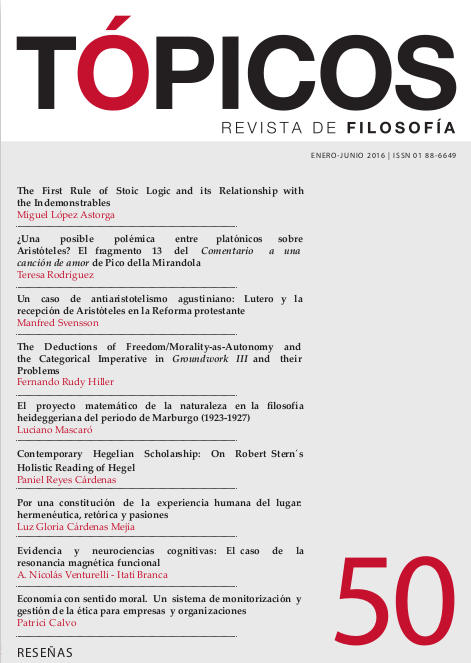¿Una posible polémica entre platónicos sobre Aristóteles? El fragmento 13 del Comentario a una canción de amor de Pico della Mirandola
Publicado 2015-12-20
Palabras clave
- Ficino,
- Pico,
- Aristóteles,
- ángeles,
- motores inmóviles
Cómo citar
Resumen
En este artículo presento un fragmento del Comentario a una canción de amor de Pico della Mirandola que muestra una preocupación filosófica no evidenciada con anterioridad. Aunque Pico y Ficino son considerados como miembros del platonismo florentino, el fragmento en cuestión apunta una posible polémica sobre la interpretación del texto en el que Aristóteles establece el número de sustancias (motores) inmóviles en Met. Λ8. Mientras que Pico se adhiere a una lectura literal, Ficino intentará hacer compatible la posición de Aristóteles con el cristianismo que, tradicionalmente, ha identificado estas sustancias inmóviles con las inteligencias angélicas. Estas dos posiciones muestran que la posición de Aristóteles en el Renacimiento no es menor ni subordinada a cuestiones meramente físicas.
Descargas
Referencias
- Allen, M. (1975). The Absent Angel in Ficino’s Philosophy. Journal of the History of Ideas, 36.2, 219-240.
- ____ (1982). Ficino five substances and the Neoplatonist’s Parmenides. Journal of the Medieval and Reinassances Studies, XII 1, 18-45.
- Aristóteles (1998). Metafísica. Valentín García Yebra (Trad.) Madrid: Gredos.
- Bacchelli, F. (2001). Giovanni Pico e Pierleone da Spoleto: tra filosofia dell’amore e tradizione cabalística. Florencia: Olschki.
- Beere, J. (2003). Counting the Unmoved Movers: Astronomy and Explanation in Aristotle’s Metaphysics XII.8. Archiv für Geschichte der Philosophie, 85.1, 1-20.
- Bori, P.C. (2000). Pluralità delle vie. Alle origini del Discorso sulla dignità umana de Pico della Mirandola. Milan: Feltrinelli.
- Blum, P. R. (2010). Philosophy of Religion in the Renaissance. Farnham: Ashgate.
- Celenza, C. (2013). What Counted as Philosophy in the Italian Renaissance? The History of Philosophy, the History of Science, and Styles of Life. Critical Inquiry, 39.2, 367-401.
- Collins, A. (1974). The secular is sacred: platonism and thomism in Marsilio Ficino’s Platonic Theology. The Hague: M. Nijho .
- Copenhaver, B. (2011). Studied as an Oration: Readers of Pico’s letters, Ancient and Modern. En Laus Platonici Philosophi. S. Clucas, P. J. Forshaw y V. Rees (Eds.) (151-198). Leiden: Brill.
- Ficino, M. (1998). De Amore, Comentario al Banquete de Platón. R. de la Villa Ardura (Trad.) Madrid: Tecnos.
- ____ (2001). Platonic Theology. M. Allen y J. Warden, (Eds). J. Hankins y W. Bowen (Texto latino). Cambridge: Harvard University Press.
- Lloyd, G. (2000). Metaphysics Λ 8. En Aristotle’s Metaphysics Lambda. Symposium Aristotelicum. M. Frede y D. Charles (Eds.) Oxford: Oxford University Press.
- Pico della Mirandola, G. (1942). Commento sopra una canzona d’amore. En De hominis dignitate / Heptaplus / De ente et uno. E. Garin (Ed.) Firenze: Vallecchi Editore.
- ____ (1958). Commentary on a Canzone of Benivieni. Sears Jayne (Trad.) Nueva York: American University Studies.
- Tomás de Aquino. (1876). Summa contra gentiles. En Opera Omnia. París: Vives.
- ____ (1950). In duodecim libros metaphysicorum Aristotelis. Turín: Marietti.






